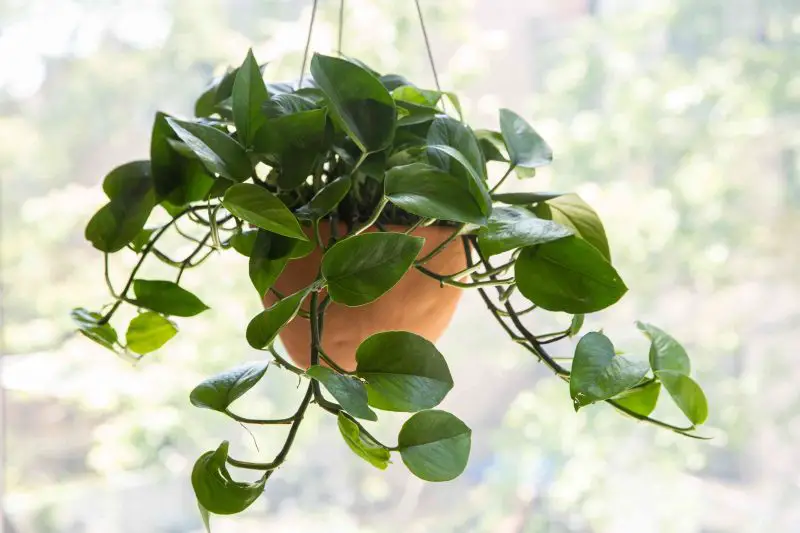Pothos, with its trailing vines and heart-shaped leaves, is one of the most beloved houseplants for both beginners and seasoned plant lovers. Its ability to thrive in a variety of indoor conditions makes it a go-to choice for adding greenery to any room, whether you place it on a shelf, in a hanging basket, or let it climb. More than just beautiful, pothos is incredibly forgiving, bouncing back from common beginner mistakes with ease.
However, even the easiest plants need proper care to truly flourish. Learning how to care for pothos properly ensures your plant doesn’t just survive—it thrives with lush growth and vibrant color. In this complete guide for beginners, you’ll discover everything you need to grow a healthy pothos, from lighting and watering to pruning and propagation.
Choosing the Right Location for Your Pothos

Finding the perfect spot for your pothos is key to encouraging strong, healthy growth. Pothos prefers bright, indirect light—such as the light found a few feet away from a sunny window. This kind of light supports vibrant leaf color and steady vine development. East-facing windows are often ideal, providing gentle morning sun that won’t scorch the leaves. South or west-facing windows can also work well, but the plant should be kept slightly away from direct rays or behind a sheer curtain to diffuse the light.
If you’re placing your pothos in a low-light room or a space without windows, like a bathroom or hallway, it can still survive but will grow more slowly. In these conditions, consider rotating the plant occasionally or supplementing with artificial grow lights for a few hours daily. Avoid placing your pothos in complete darkness or under harsh, direct sun, both of which can cause leaf discoloration or slow growth.
Temperature also plays a part when choosing the right location. Keep the plant away from cold drafts near windows during winter and avoid placing it directly in front of heaters or air conditioning vents. Stability in temperature and light helps prevent stress and ensures your pothos adapts comfortably to its environment.
Understanding Pothos Watering Needs
Watering is one of the most important aspects of pothos care, and also one of the easiest places to go wrong—especially for beginners. Pothos prefers its soil to dry out slightly between waterings. This means you should avoid watering on a fixed schedule. Instead, check the top inch of soil with your finger. If it feels dry, it’s time to water. If it’s still moist, wait a few more days. This method helps prevent overwatering, which is one of the leading causes of yellowing leaves and root rot.
When watering, do so thoroughly until excess water drains out of the bottom of the pot. This ensures that the entire root system receives moisture. Always empty the saucer afterward to avoid letting the plant sit in standing water. Using a pot with good drainage holes is essential for healthy roots.
The frequency of watering will vary depending on several factors. In warmer months or during periods of active growth, your pothos may need watering once a week or even more frequently. In cooler seasons or when placed in low-light environments, the plant requires less water, sometimes only every two to three weeks. Humidity levels in your home also affect how quickly the soil dries out.
Signs that your pothos needs water include slightly drooping leaves and dry soil. However, if the leaves become soft and wilted even after watering, root rot may already be present due to overwatering. On the other hand, brown or crispy leaf edges often indicate underwatering or a prolonged dry period.
Using room temperature, filtered, or distilled water can also benefit the plant, especially in areas with hard tap water. Some pothos varieties are sensitive to high chlorine or fluoride levels, which may cause leaf tips to brown over time. Letting tap water sit out overnight before use can help reduce these chemical levels.
Consistently observing your pothos and adapting your watering habits based on its needs and environment is the best way to keep it thriving.
Best Soil and Potting Mix for Healthy Roots
To grow a healthy pothos, choosing the right soil mix is essential. Pothos needs a light, well-draining potting medium that retains moisture without becoming soggy. The roots require both water and air, so the soil must balance moisture retention with good aeration.
A high-quality indoor potting mix with added perlite or pumice works well. Perlite improves drainage and creates space for air to flow around the roots, reducing the risk of rot. You can also mix in coconut coir or orchid bark to enhance structure and prevent compaction over time. A common blend includes two parts potting mix, one part perlite, and one part coco coir or bark.
Avoid using garden soil or dense compost, which holds too much water and may suffocate the roots. Make sure the pot has drainage holes to let excess water escape. Repotting with fresh soil every 1 to 2 years also helps maintain root health by refreshing nutrients and improving soil texture.
Ideal Temperature and Humidity for Pothos
Pothos thrives in warm, humid environments similar to its tropical origins. The ideal temperature range for healthy growth is between 65°F and 85°F (18°C to 29°C). Within this range, the plant grows actively and produces lush foliage. When temperatures drop below 60°F (15°C), growth slows down, and prolonged exposure to cold under 50°F (10°C) can damage leaves and cause them to yellow or fall off. To protect your plant, keep it away from cold drafts, open windows in winter, and direct blasts from air conditioners.
Humidity is equally important. Pothos prefers relative humidity between 40% and 60%. Low humidity, especially during winter or in dry climates, can cause brown tips and leaf curling. A hygrometer helps you monitor indoor levels. To raise humidity, you can mist the plant, place it on a pebble tray with water, group it with other plants, or use a humidifier. Just be sure the air still circulates well to avoid excess moisture that can lead to fungal issues.
Maintaining stable warmth and moderate humidity will closely replicate the pothos’ natural habitat, encouraging vibrant, consistent growth.
Fertilizing Your Pothos for Strong Growth
While pothos isn’t a heavy feeder, occasional fertilizing plays a key role in promoting strong, healthy vines and fuller foliage. During the active growing seasons of spring and summer, feeding your plant once a month with a balanced, water-soluble houseplant fertilizer—such as a 10-10-10 or 20-20-20 formula—can supply essential nutrients like nitrogen for leaf development, phosphorus for root strength, and potassium for overall vigor.
It’s best to dilute the fertilizer to half the recommended strength to avoid overfeeding, which can lead to salt buildup in the soil and damage the roots. You can also opt for organic alternatives like worm tea or compost extract, which provide a gentler, slow-release nutrient boost.
In fall and winter, when the plant’s growth naturally slows, reduce or pause fertilization to prevent stressing the roots. If your pothos was recently repotted into fresh soil, you can wait about 4–6 weeks before starting fertilization, as most commercial potting mixes already contain enough nutrients to support new growth.
Regular but moderate feeding, timed with the plant’s natural growth cycle, helps ensure your pothos stays vibrant, lush, and full of life.
Pruning and Training for Fuller Vines
Pruning is essential for keeping your pothos looking full, tidy, and vibrant. Regularly trimming long or leggy vines encourages the plant to branch out from the nodes, resulting in a denser, bushier appearance. To prune effectively, use clean, sharp scissors and make your cuts just above a leaf node—the point where a leaf and aerial root meet the stem. This stimulates new growth from that node, allowing the plant to produce multiple shoots instead of a single trailing stem.
Training your pothos is another way to shape its growth and enhance its decorative impact. You can guide the vines to climb a trellis, moss pole, wall hooks, or even a shelf edge. As the vines grow, gently secure them with soft ties or clips to support upward or horizontal spreading. This method not only creates a more dramatic display but also encourages more light exposure to all parts of the plant, which can further boost leaf size and health.
Regular pruning combined with intentional training not only improves the plant’s appearance but also revitalizes older vines, prevents overcrowding, and supports more balanced, vigorous growth throughout the year.
How to Repot Pothos When It Outgrows Its Pot
As pothos grows, its root system gradually fills the pot, eventually becoming root-bound. Signs that your plant needs repotting include roots circling the inside of the pot, growing out of drainage holes, or visible stunting in vine and leaf growth. In this state, the plant may struggle to absorb water and nutrients efficiently, making repotting essential for continued health.
The best time to repot pothos is in spring or early summer, when the plant is entering its active growth phase. Start by choosing a new pot that is 1 to 2 inches wider in diameter than the current one, and make sure it has proper drainage holes. Prepare fresh, well-draining soil that includes peat moss, perlite, or coconut coir to support healthy root development.
Gently remove the plant from its current container, being careful not to damage the roots. If the root ball is tightly wound, use your fingers to tease it apart slightly. Place the plant into the new pot, positioning it at the same depth as before. Fill in the surrounding space with fresh soil and press it down lightly to eliminate air pockets.
After repotting, water the plant thoroughly to help the soil settle and reduce transplant shock. Place your pothos in a spot with bright, indirect light and avoid fertilizing for the first few weeks, as the fresh soil already contains nutrients. With a new home and room to grow, your pothos will quickly resume healthy, vigorous growth.
Propagating Pothos to Multiply Your Collection
Propagating pothos is an easy and effective way to grow new plants from your existing one. The most popular method is stem cutting, which works best during the warmer months when the plant is actively growing. Choose a healthy vine and cut a section about 4 to 6 inches long, making sure it includes at least one node. Remove the lower leaf so the node can root more easily.
Place the cutting in a jar of clean water, keeping the node submerged and the leaves above the surface. Set it in a spot with bright, indirect light and change the water every few days. Roots usually appear within 1 to 2 weeks and are ready for planting once they’re about an inch long.
You can also plant the cutting directly into moist soil and keep the humidity high to encourage rooting. Once established, new plants can be grown in their own pots or added back into the mother plant’s pot for a fuller look. This simple method is a great way to expand your collection or share pothos with others.
Common Problems and How to Solve Them
Pothos is easy to care for, but issues can still arise if its needs aren’t met. Yellowing leaves are often caused by overwatering and poor drainage. Let the soil dry out between waterings and ensure the pot has drainage holes. If roots are rotting, trim the damaged parts and repot in fresh soil.
Brown or crispy leaf edges usually mean the air is too dry or the plant hasn’t been watered enough. Raise humidity with a tray of water, misting, or a humidifier, and water only when the top inch of soil is dry.
Pale leaves or loss of variegation often signal low light. Move the plant to a spot with bright, indirect sunlight. Avoid direct rays that can scorch the leaves.
Drooping leaves may mean underwatering or overwatering. Check the soil—water if it’s dry, wait if it’s wet.
Pests like spider mites and mealybugs can appear in dry, dusty environments. Look for webbing or sticky residue. Wipe leaves with a damp cloth and apply neem oil or insecticidal soap.
Monitoring your plant regularly and adjusting care quickly will keep your pothos healthy and thriving.
Seasonal Pothos Care Tips
Pothos care should adjust slightly with the seasons to match its natural growth cycle. In spring and summer, the plant grows more actively, so water more frequently, provide bright indirect light, and fertilize monthly to support healthy new growth.
In fall, growth begins to slow. Reduce watering and pause fertilizing to avoid buildup in the soil. Keep the plant warm and move it closer to windows if natural light decreases.
During winter, pothos enters a semi-dormant phase. Water less often, as the soil dries out more slowly in cooler temperatures. Avoid placing the plant near cold drafts or heating vents, which can cause stress or leaf damage.
By shifting your care routine with the seasons, you help your pothos stay strong, lush, and responsive to its changing environment.
Frequently Asked Questions (FAQ) About Caring for Pothos
How often should I water my pothos?
Watering frequency depends on your environment, but generally, you should water when the top inch of soil feels dry. In warm, bright conditions, this might be once a week. In cooler or lower-light environments, watering every 10 to 14 days may be enough. Always adjust based on how fast the soil dries out and avoid letting the plant sit in soggy soil to prevent root rot.
Why are my pothos leaves turning yellow?
Yellow leaves are usually a sign of overwatering or poor drainage. When roots stay wet for too long, they can’t absorb oxygen properly, leading to root rot and leaf discoloration. Make sure your pot has drainage holes and allow the soil to dry slightly between waterings. Less commonly, yellowing can also be caused by old age, sudden temperature changes, or nutrient deficiencies.
Can pothos grow in low light?
Yes, pothos can tolerate low-light conditions, making it ideal for dim rooms or offices. However, in lower light, the plant will grow more slowly, and variegated varieties may lose some of their color. For best results, place pothos in bright, indirect light to encourage fuller vines and maintain leaf color.
How do I make my pothos look fuller?
To encourage a bushier pothos, prune regularly by trimming just above leaf nodes. This stimulates branching and prevents the plant from becoming too leggy. You can also propagate cuttings from trimmed vines and plant them back into the same pot once rooted, creating a denser, fuller appearance over time.
What kind of fertilizer should I use, and how often?
Use a balanced, water-soluble houseplant fertilizer (like 10-10-10 or 20-20-20) diluted to half strength. Apply it once a month during spring and summer when the plant is actively growing. Reduce or stop fertilizing in fall and winter. If you prefer organic options, worm castings or compost tea can also support steady growth without chemical buildup.
Conclusion: Keeping Your Pothos Thriving Year-Round
With the right care, pothos can reward you with long, vibrant vines and lush foliage for years. Its low-maintenance nature makes it a perfect starting point for plant lovers and busy homeowners alike. By understanding its preferences for light, water, temperature, and feeding, you can enjoy a healthy, beautiful plant that grows with minimal effort. Whether you’re decorating a shelf or letting it trail from a hanging pot, your pothos will thrive when given a little consistent attention and love.






